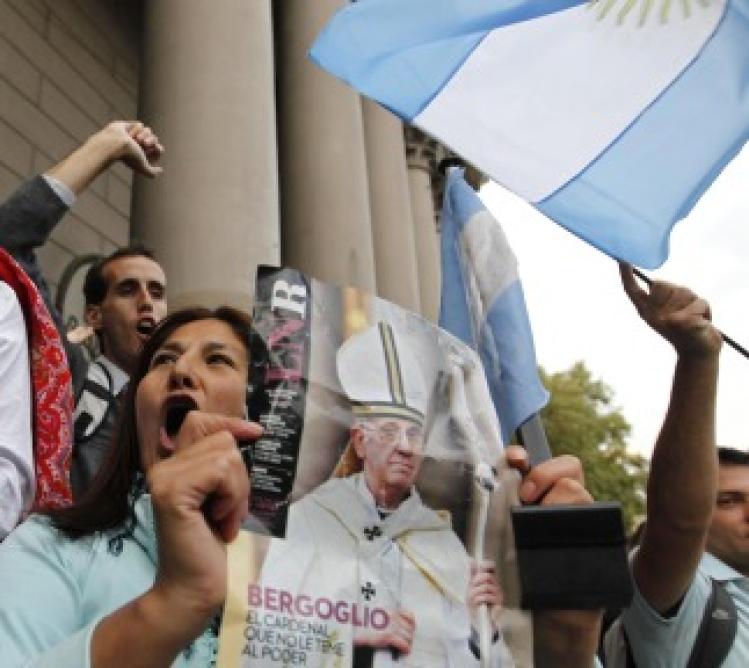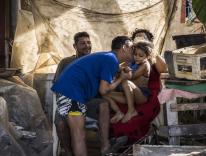
A Latin-American pope! From Chile to Mexico—and among U.S. Latinos—there was a collective gasp of surprise and excitement over the news of the conclave’s election of Argentina’s Cardinal Jorge Mario Bergoglio as Pope Francis.
In Buenos Aires, ecstatic worshipers waving Argentine and Vatican flags packed the Metropolitan Cathedral. In Mexico City’s main plaza, the Zócalo, cathedral bells rang. Even Venezuela’s new president, Nicolás Maduro, got in on the action, happily speculating that recently deceased Hugo Chávez must have pulled strings in heaven so that Jesus would appoint a South American to the job. In the United States, Latino immigrants from Los Angeles to Wilmington, North Carolina, expressed joy and thanksgiving at the selection of a pope who shares their language, culture, and heritage.
Some pundits speculated that the enthusiasm over the selection of Bergoglio may strengthen the political position of the Latin-American church. In the New York Times, novelist Martín Caparrós proposed that an Argentine pope would raise the power of conservative groups in that country to “uncharted heights.” Other commentators focused on the potential for Pope Francis to revitalize and reenergize the Latin-American faithful.
In order to assess the possible impact of the new pope on Latin-American Catholicism, however, it is necessary to understand several highly complex and deeply entrenched challenges. Although Latin America remains predominantly Catholic, its various national societies are changing in ways that will affect both institutional Catholicism and the life of the Catholic masses.
The first of these challenges is demographic. Today, Latin America and the Caribbean are home to about 40 percent of the world’s Catholics. Across the region, however, Catholics have been leaving the faith in droves. Most of those who have left converted to various strains of evangelical Protestantism, but many are also simply becoming secularized. According to the Pew Research Center, the share of the region’s population that is Catholic has decreased from about 90 percent at the beginning of the twentieth century to 72 percent in 2010.
The most striking fact about this attrition is how recently and rapidly it has occurred. According to scholar Virginia Garrard-Burnett, the Catholic population in Brazil—Latin America’s most populous country—has declined by 20 percent over the past thirteen years. In Guatemala over the past several decades, almost one-third of the country’s Catholics have left the church. Sociologist Roberto Blancarte estimates that the Catholic population in Mexico has declined by 4 million (from 89 to 82 percent) since 2000.
The picture is similar among Latinos in the United States, who today make up about one-third of U.S. Catholics. A January 2013 Gallup poll determined that the percentage of Latino Catholics is decreasing relative to Latino Protestants in the United States, and that religious enthusiasm is significantly higher among Protestants than among Catholics. Even more notable are the changes within the younger generation of Latinos: the same poll found young Latino Catholics (between the ages of eighteen and twenty-nine) are much less likely to identify as “very religious,” while 24 percent did not consider themselves religious at all.
At the same time that Catholics are leaving the faith, the institutional Catholic Church in Latin America has faced a second, more enduring challenge: a long decline in its historical position of privilege, power, and political relevance—and a concurrent decline in its public image.
Ever since the region’s nations gained independence from Spain, governments have struggled with the Catholic hierarchy over the role of the church relative to the state. Throughout the nineteenth century, liberal politicians and intellectuals—emboldened by Enlightenment ideas about the separation of church and state—sought to restrict the powers, property, and privileges that the clergy had held since the colonial period. Conservatives, by contrast, tried to preserve a central role for the church in the public sphere, especially in education. As a result, the institutional church tended to support conservative governments in the nineteenth century, even though the Catholic masses—and often, the lower-level Catholic clergy—were more ideologically diverse.
This alliance between the hierarchy and conservative governments was complicated somewhat during the twentieth century. In the early 1900s, the church seemed poised to head to the left: in the wake of the 1891 papal encyclical Rerum novarum, the church had entered a period of heightened concern for the welfare of the working classes, and increased its involvement in and support for social action. As ideological conflicts in Latin America became increasingly polarized between conservative military dictatorships and leftist and populist regimes, however, new political divisions arose.
As historian John Schwaller describes (see “A Transplanted Faith,” December 21, 2012), by the mid-twentieth century the church was divided between a highly conservative political and cultural right wing opposed to social change; a radical left (primarily among the lower clergy) that sympathized with revolutionary armed struggles; and a large and moderate center that sought to work within existing political structures to bring about social justice, economic equality, and human rights. Thus, the church’s response to political developments in twentieth-century Latin America depended upon the relative strength of each wing within any a particular country.
In the case of Argentina, the conservative hierarchy remained largely silent during the country’s “dirty war” (1976–83), in which the military government was brutally repressive towards people accused of being leftists. (Hence the barrage of questions and accusations about Bergoglio’s actions and involvement with the government during that period.)
In other countries, however, the Catholic Church actually stood up to right-wing dictators. In the Dominican Republic, a new generation of liberal bishops broke with dictator Rafael Trujillo in the early 1960s; in Brazil at the same time, the progressive bishops took a public stand against the military dictatorship and defended victims of torture and repression. In Central America during the 1970s, ’80s, and ’90s, members of the hierarchy were persecuted and killed for expressing sympathy for the poor and for actively and publicly opposing military governments. Most famously, numerous prominent clergy supported Catholic liberation theology, which emphasized the need to redress economic and social inequality and give special attention to the poor (the Vatican has strongly critiqued these teachings, but both John Paul II and Benedict XVI spoke in Latin America about the problem of economic inequality).
These human-rights accomplishments should have helped to burnish the image of the Latin-American church. Yet, in recent years, the church has struggled to respond to a new wave of leftist regimes, often taking a critical stance toward populist leaders such as Venezuela’s Hugo Chávez and Bolivia’s Evo Morales. For their part, these politicians have reminded their supporters of the historical association between the Catholic Church and reactionaries, wealthy elites, and the military. Thanks in part to those ties (and thanks also to a growing scandal over the sexual abuse of minors by priests in Latin America), the hierarchy in Latin America today has something of an image problem.
There is a third and final challenge that Pope Francis will confront in Latin America, and this may be the most daunting of all: the newest wave of social and cultural change that is occurring across the region, particularly in urban areas. Since the 1990s, Latin Americans have become more socially liberal on issues such as same-sex marriage, contraception, and abortion. Argentina legalized same-sex marriage in 2010, and Uruguay in 2013. Mexico City, which hosts an enormous gay-pride parade every year, legalized same-sex marriage in 2010 (though it is not legal nationwide).
Although abortion is still widely restricted across the region (and is completely banned in five countries), Mexico City legalized abortion in 2007, and Uruguay voted to legalize abortion in 2012. Finally, the church’s position on contraception is widely ignored in most countries, some of which have initiated state-sponsored programs that distribute contraceptives. Bergoglio was an outspoken opponent of such initiatives. Some new sociological and anthropological studies, such as one by anthropologist Lara Braff, demonstrate that women are increasingly unlikely to take Catholic doctrine into account when deciding how many children to have.
While Latin-American Catholics are still more socially conservative than those in the United States and Europe, there’s still an important gap between popular religiosity and doctrinal adherence. Popular Catholicism across the region is a syncretic mix of precolonial beliefs, African-influenced religious practices, rural and popular folkways (such as shamanism and curanderismo), and personal and regional devotion to individual saints. To the persistent frustration of the Catholic hierarchy from colonial times to the present, Latin-American Catholics have had historically low rates of sacramental participation, especially among the poor. Relatively few nonelite couples, for instance, chose to participate in the sacrament of marriage. This practice goes back to the colonial period. Historically, Latin Americans have had markedly lower levels of Mass attendance than those in the United States.
The three challenges that Pope Francis must confront in Latin America—attrition, a growing image problem, and sociocultural change—are deep and historical, but they may not be intractable. After all, the Latin-American church is still enormous, with an active and dynamic laity who have deep devotion and a strong sense of cultural Catholicism.
Perhaps Francis, who has named himself after a saint well known for his devotion to the poor, will turn the church’s attention squarely back to issues of social justice and inequality. This would certainly be welcomed by Latin-American Catholics, as well as by Latinos in the United States. Patriotic excitement and enthusiasm over his appointment may even help to stem the tide of converts to evangelical Protestantism. And although it is hard to imagine that Latin Americans will become more socially conservative, especially on questions of sexual morality, perhaps this will not be Francis’s principal focus in the region. However he proceeds, the new pope will have his work cut out for him.
Please email comments to [email protected] and join the conversation on our Facebook page.
Previous Story
Is this "the modern mind"?
Next Story
Just saw this..

